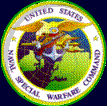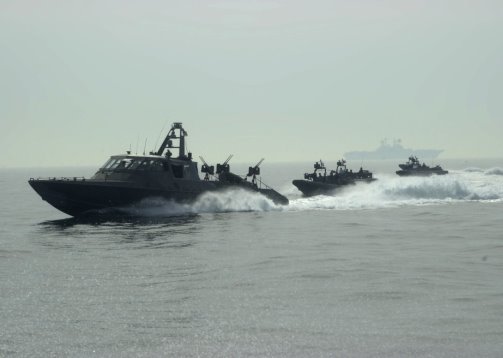NSW Press Release

|
PRESS RELEASE Naval Special Warfare Command Public Affairs Office 2000 Trident Way |
October 8, 2003 For Immediate Release (PR 03-14)
Special Boat Teams: The ‘Wave’ of the Future Fight
By Journalist 1st Class (SW/AW) Sonya Ansarov, Naval Special Warfare Command Public Affairs
NAVAL AMPHIBIOUS BASE, CORONADO, Calif.– High speed, sharp turns, the ability to stop on a dime, stealthy, and enough firepower to make the enemy think twice about attacking make the MK-V (Mark-Five) boats a formidable weapon for fighting in the global war on terrorism. But it’s the Special Warfare Combatant-craft Crewmen (SWCC – pronounced “swick”) that make the MK-Vs — and other special operations surface craft — more than just boats.
SWCCs, also referred to as “the Boat Guys,” are a major component of Naval Special Warfare. They are highly-trained individuals who operate and maintain the state-of-the art, high-performance craft used in maritime special operations missions, such as overseas coastal patrol and surveillance, and Maritime and Leadership Interdiction Operations (boarding and searching vessels suspected of smuggling contraband or terrorists).
SWCCs of Special Boat Team 12 (SBT-12) from San Diego proved their worth and special skills during Operation Enduring Freedom where they boarded and searched 21 vessels, captured 18 highly-ranked terrorists trying to escape the Middle East via the Arabian Sea, and stopped the smuggling of 3,500 metric tons of oil.
Most recently, SBT-12 showed what they were made of during two major missions in Operation Iraqi Freedom. The first mission was the securing of the two main oil distribution platforms of the Al Faw peninsula and the offshore gas and oil terminals in Iraq.
“We were able to get SEALs and other special operations forces to the platforms, and then provided cover for them,” said Intelligence Specialist 2nd Class (SWCC/DV) Herbert Clay, MK-V assistant boat captain. “It was vital that the oil platforms and the off-shore terminals were shut down at exactly the same time to prevent the pipes from bursting, and causing the mission to be all for nothing. This was an important mission during the war because it prevented Saddam Hussein from sabotaging the platforms and causing a major environmental disaster similar to what he did in the first Gulf War.”
The second mission involved SWCCs clearing and securing of the Khor Al Abdullah and Khor Az Zubayar waterways, which enabled the first delivery of humanitarian aid to the port city of Umm Qasr. It was also a history making first for the MK-V.
“This was the first time in history for a MK-V to operate in a river,” said Operation Specialist 2nd Class (SWCC) Brian Dillon, MK-V navigator. “We were the first ones up the river and it was difficult to navigate because I didn’t have any navigational charts for the river. It had never been charted before. There were numerous boat wreckages floating in the river, plus we had to deal with bad weather, from thick fog to sand and rainstorms, and extreme tidal changes. The craziest thing was we were about half way up the river when mines were discovered behind us — the same path we just crossed — and in front of us. We stopped where we were and waited for the mine sweeper ships to clear the mines.”
Once the mines were cleared, SWCCs continued their mission of securing the river, ensuring enemy forces weren’t hiding among the boat wreckage and preventing vessels from trying to pass by them to get down river.
“We were clearing about 22 vessels a night,” said Dillon. “We would put special operation forces on board to scout for enemy targets trying to escape, oil being smuggled, and to make sure the vessel wouldn’t be a threat to our forces or anyone else.”
Being in a hostile environment was something new for some of the SWCCs.
“This was my first time to go to war,” said Hull Maintenance Technician 2nd Class (SWCC) Michael Nelson, MK-V weapons specialist and gunner. “We had to call on a lot of our skills that we hadn’t used yet when it came to operating in the river and dealing with the enemy. Sometimes the rough water, cold winds, and the darkness would start to get to me, but then my training would kick in and everything was fine. Being out there also brought us closer together as a group, which was amazing because we are already a close-knit team just by virtue of being a SWCC.”
In addition to SBT-12’s two main missions for Operation Iraqi Freendom, SWCC’s helped check and clear 110 suspicious vessels of having contraband or suspected terrorists, and captured 31 enemy prisoners of war during their five-month deployment.
-CNSWC-
For more information on Naval Special Warfare visit the website: www.seal.navy.mil

CENTRAL COMMAND AREA OF RESPONSIBILITY -- Naval Special Warfare Combatant-craft Crewmen (SWCC) operate their special operations crafts: which are a Mk-V (Mark five)(left) and two Rigid-hull Inflatable Boats (RHIBs) from a forward location during Operation Iraqi Freedom. Both craft are used to support Naval Special Warfare Operations. Official U.S. Navy photo by Photographer’s Mate 1st Class (SW) Arlo K. Abrahamson, Fleet Combat Camera Group Pacific.